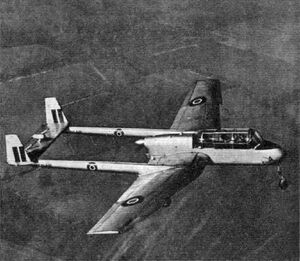Engineering:Heston JC.6
| Heston JC.6 | |
|---|---|

| |
| Heston JC.6 "AOP A.2/45" (VL529) | |
| Role | Air observation monoplane |
| National origin | United Kingdom |
| Manufacturer | Heston Aircraft Company |
| First flight | August 1947 |
| Number built | 2 |
The Heston JC.6 was a British prototype air observation post aircraft designed and built by the Heston Aircraft Company Limited, who had previously built the Heston Phoenix, the Heston T.1/37 and the Napier-Heston Racer. The JC.6 was also known as the Heston A.2/45 or the Heston AOP.
Development
The Heston JC.6 was designed and built to meet Air Ministry Specification A.2/45 for an "air observation post" (AOP) for the British Army. Heston Aircraft built two prototypes, the first, serial VL529, first flew in August 1947. The second, serial VL530, was not flown.
The JC.6 was an all-metal cantilever monoplane with twin booms and two vertical tail surfaces joined by a single horizontal tailplane. It was powered by a rear-mounted de Havilland Gipsy Queen six-cylinder aero engine fitted between the twin booms and driving a pusher propeller. The two-seat tandem cockpit was covered with a large glazed canopy. The JC.6 had a tricycle landing gear and the mainplane was fitted with slots and flaps to give Short takeoff and landing performance. During the evaluation trials the rival Auster AOP.6 had a better performance and was ordered into production. Two further Heston JC.6s, serials VL531 and VL532, were not built.[1]
A floatplane version was designed by Saunders-Roe as the Saro P.100, but was not built.
Specifications (JC.6)
Data from Flight International[2]
General characteristics
- Crew: 2
- Length: 34 ft (10 m)
- Wingspan: 44 ft (13 m)
- Height: 9 ft (2.7 m)
- Wing area: 274 sq ft (25.5 m2)
- Gross weight: 3,050 lb (1,383 kg) (design)[3]
- Powerplant: 1 × de Havilland Gipsy Queen 33 6-cylinder inverted air-cooled in-line piston engine, 240 hp (180 kW)
- Propellers: 2-bladed constant speed propeller, 7 ft 6 in (2.29 m) diameter [3]
Performance
- Maximum speed: 125 mph (201 km/h, 109 kn)
- Range: 745 mi (1,199 km, 647 nmi)
- Wing loading: 11.3 lb/sq ft (55 kg/m2)
See also
Aircraft of comparable role, configuration and era
- Auster A.2/45
- Auster AOP9
- Consolidated-Vultee L-13[4]
Notes
- ↑ Lewis, Peter (November 1972). Air Pictorial. UK: Seymour Press Ltd. p. 441.
- ↑ "ARMX CROW'S NEST". Flight: 284. 11 March 1948. https://www.flightglobal.com/pdfarchive/view/1948/1948%20-%200334.html. Retrieved 26 November 2017.
- ↑ 3.0 3.1 Bridgman 1948, p. 77c
- ↑ "Production for the CS. Air Force" Flight 11 November 1948 p563
References
- Bridgman, Leonard (1948). Jane's All the World's Aircraft 1948. London: Sampson Low, Marston & Company, Ltd..
- Lewis, Peter (November 1972). "Heston Aircraft". Air Pictorial (UK: Seymour Press Ltd) 34 (11): 440–445.
- Taylor, Michael J. H. (1989). Jane's Encyclopedia of Aviation. London: Studio Editions.
- Flight 2 September 1948
- Flight 11 March 1948 Army's Crow's Nest
External links
- airwar.ru (Russian)
 |

